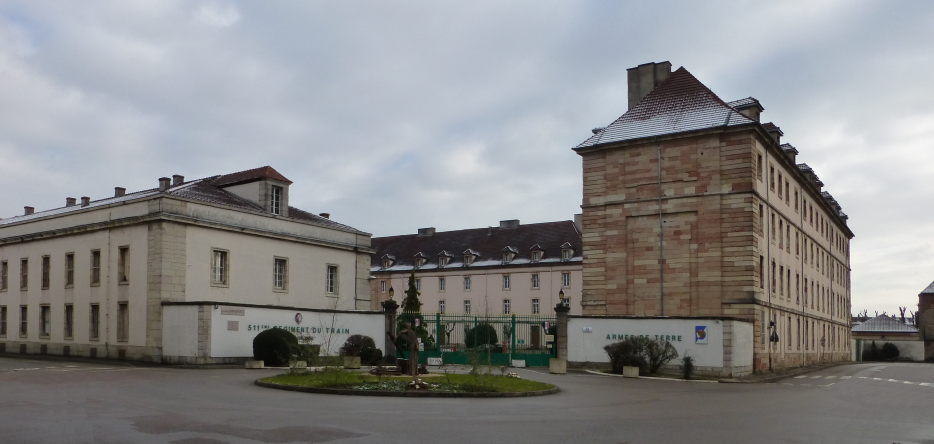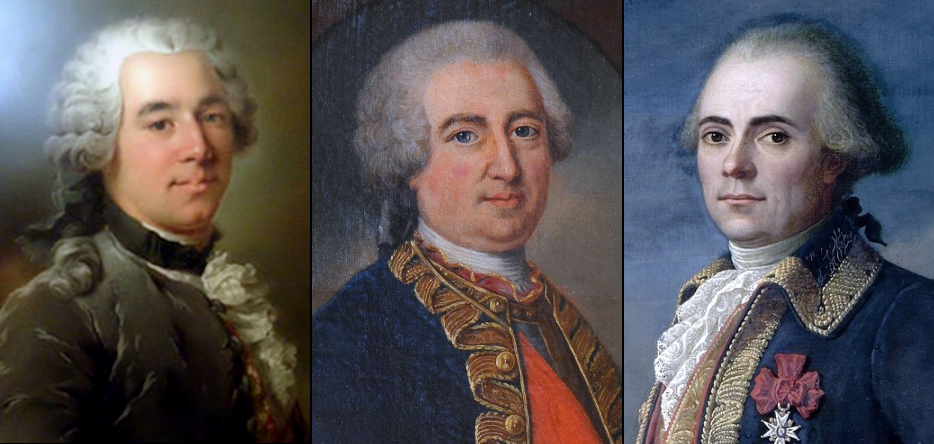Auxonne [47.19394, 5.38783] - which is locally pronounced both [os̪ɔn̪] and [oks̪ɔn̪] - is a small Burgundian town located on the banks of the river Saône , some thirty kilometers east-southeast of Dijon. In 1788, it had around 3,600 souls, to which were added some 1,200 officers and students from the La Fère artillery regiment, which had garrisoned the Royal Artillery School since the previous year.

Bonaparte's first stay
Second Lieutenant Napolionne de Buonaparte arrived in Auxonne on June 15, 1788, from Ajaccio where he had spent six months on leave. There he joined the La Fère artillery regiment, to which he had belonged since October 1785, and which held quarters in barracks northeast of the city.
At the Barracks, Bonaparte stayed in the Pavillon de la Ville (south pavilion) , staircase 1 (to the east), room number 16 [nowadays room 25] on the third floor, south side.
There he rubbed shoulders with other young officers such as:
- his best friend Alexandre des Mazis (who had been already his comrade at the Ecole Militaire de Paris then in garrison in Valence)
- Joseph-Louis-Victor Jullien de Bidon (future General, Prefect of the Morbihan department and State councilor)
- Jean André Louis Rolland de Villarceaux (future Prefect of the Tanaro, then Apennines then Gard departments)
- Jean Barthélemot de Sorbier (future First inspector of artillery)
- David Victor Belly de Bussy (whom he would name Colonel of artillery and aide-de-camp in 1814 after the Battle of Craonne)
- Jean Baptiste Le Lieur de Ville-sur-Arce (future General Intendant of Crown Parks and Gardens)
- Claude-Joseph de Malet, from Dole (brother of the future conspirator of 1812).
Bonaparte also frequented older officers, such as captains Jacques Marie Charles de Drouas de Boussey (future General) and Jean Jacques Basilien Gassendi (future General, Inspector general of artillery and State councilor) who commanded the company in which the young Corsican was serving.
With his fellow officers, he took his meals (often only one per day) at the pension run by Jeanne Chevalier, widow of Dumont, rue de Saône [rue Vauban today] , and used to go to the café located opposite to the barracks to have a glass of milk.
He showed himself to be an excellent student, notably being noticed by his mathematics teacher Jean-Louis Lombard, who had been teaching this science for forty years, and who noted: This young man will go far
. He regularly received Napoleon at his home on rue de Saône [now number 6 rue Vauban] .
The maneuvers and artillery firing take place at the artillery polygon located in Tillenay, on the right bank of the Saône River , a few kilometers from the town. Napoleon Bonaparte has the honor of being entrusted with the direction of operations during an inspection visit from the Prince Louis V Joseph de Bourbon-Condé.
During the year 1789 he had the opportunity to lead several external missions. On March 31, the Marquis de Gouvernet, lieutenant of the province, sent three companies to Seurre, following the start of a riot linked to the famine following the bad harvests of 1788; one of these companies, of 106 men, was placed under the command of Bonaparte; arriving in Seurre the next day, he restored calm and remained there until May 29.
During this stay, he was invited to dinner by Claude de Thiard de Bissy, Governor of Auxonne and former friend of King Louis XV, at his castle of Pierre-de-Bresse, and went to celebrate Easter with Noël-Antoine Prieur, Receiver general of the finances of the bailiwick of Dole and Receiver of the salt store of Auxonne, where he met the charming wife Pierrette.
In May, he went with a detachment to the abbey of Cîteaux to resolve an insurrection of monks (according to some authors, others placing this revolt in May 1790, while Napoleon was again in Corsica), then in June to Dijon during emerging parliamentary unrest.
On July 19, 1789, it was in Auxonne itself that he had to suppress a new popular riot, following the announcement of the Storming of the Bastille in Paris (the flashpoint of the French Revolution). That day he was at the head of 450 men. On August 23, Place des Casernes [47.19549, 5.38975], he, like all officers, took the oath of loyalty to the Nation, the King and the Law.

This first stay in Auxonne also left Napoleon with some leisure. The summer following his arrival, he almost drowned in the river Saône while swimming, only being saved by a providential sandbank.
He liked to go to the village of Villers-Rotin, on the road to Dole, where he found a young girl named Marie Merceret, six years his senior, under a Sully lime tree [47.15681, 5.40548] planted on the occasion of the birth of future King Louis XIII in 1601, near the church [tree now disappeared] . Or to the Chapelle de la Levée [since renamed Chapelle Napoléon] [47.19775, 5.35358] in Villers-les-Pots, near the road to Dijon .
The young and dark lieutenant did not leave the gracious Countess of Berbis indifferent, who frequently received him both in her private mansion in Auxonne [at current number 7 rue de Berbis] and in her Château des Maillys [47.13755, 5.33556], about ten kilometers to the south.

He was a regular guest at the home of François Laurent Pillon d'Arquebouville, Director of the arsenal and artillery of Burgundy, on rue de Chénois [today 2 bis rue Carnot] , in the company of the Lombard couple, for innumerable lottery games.
He also frequented the Commissioner of Wars Jean-Marin Naudin, whose wife, a very pretty woman, had lived in Corsica for fifteen years.
Baron Jean Pierre du Teil de Beaumont, Director of the Ecole d'Artillerie, also received him at his private mansion [#25 of current rue Thiers] , with great kindness; Napoleon remembered this when writing his will, bequeathing 100,000 francs to his children or grandchildren "as a token of gratitude for the care this brave general took of us, when we were lieutenants and captains under his command".
On September 9, 1789, he left Auxonne on half-year leave for Ajaccio.
Bonaparte's second stay
Napoleon Bonaparte arrived in Auxonne on February 11 or 12, 1791, accompanied by his brother Louis. In the same south pavilion as in 1788, but this time on the 2nd floor of staircase 3, north side, he occupied room number 14-15 [now room number 10, preserved as is], with Louis sleeping in the anteroom.
It was at this time that he drew a sundial on the south façade of the Barracks' north pavilion (known as the Pavillon Royal), which can still be seen today.
Having written a "Letter to Mr Matteo di Buttafuoco" on January 23, 1791 (the last day he was in Corsica before embarking), denouncing the treachery of the Corsican deputy, royalist leader and opponent of Pascal Paoli, towards this nation, Napoleon visited the printer Jean-François Xavier Joly in Dole on three occasions. Once the proofs had been corrected, 100 copies of the opuscule were printed.
During this second stay, Bonaparte made several visits to Nuits-Saint-Georges, where the recently married Captain Gassendi invited him to dinner. He also paid another visit to Cîteaux Abbey (May 23, 1791), and toured with his friend Alexandre des Mazis the cannon foundry built in Le Creusot-Montcenis by Ignace de Wendel in 1782.
Appointed First lieutenant in the 4th Artillery Regiment at Valence on June 1, 1791, Napoleon left Auxonne on June 14.
A bronze statue of the young Napoleon Bonaparte in artillery lieutenant's uniform , the work of sculptor François Jouffroy, has been enthroned in the middle of Auxonne's Place d'Armes since 1857; its base features four bronze bas-reliefs depicting, respectively:
- the young Bonaparte meditating under an oak tree
- the bridge of Arcole
- Bonaparte presiding over a session of the Conseil d'Etat
- the Coronation .
Photo credits
Photos by Didier Grau.Photos by people outside the Napoleon & Empire association.